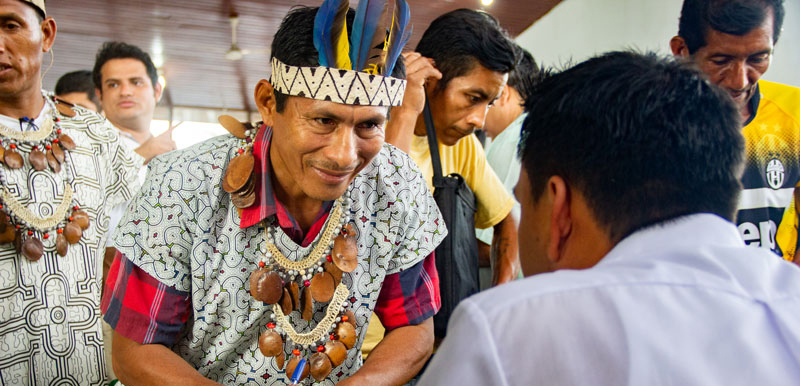2020-02-04
Two important ceremonies have taken place in Peru, marking collaborative efforts between indigenous communities, the State, and civil society, to title swathes of communal forest land, as the Peruvian Government continues its ambitious push to implement the “Wasiy National Plan”, which aims to deliver one million titles over the next four years.
The first ceremony, on December 20, took place in the facilities of the Regional Government of Loreto, where indigenous leaders from all the federations of the region received 21 community titles from the regional Governor. Loreto has 1182 recognized indigenous communities, of which 39% do not yet have a title. The State has committed to decreasing this percentage to zero in the next two years.
This latest community title recognizes 175,787 hectares of indigenous territory, benefiting over 2,000 people from 12 ethnolinguistic groups.

Lizardo Cauper, president of the Interethnic Association of the Peruvian Jungle (Aidesep), stressed that this titling achievement is the result of partnership between government, indigenous organizations and civil society. “We will (continue) to contribute to making Loreto an example of an Amazon region where indigenous peoples are recognized, and where we all respect each other,” he said.
The second ceremony was held in Shintuya on December 21. This native community belongs to the Harakbut people and is located on the banks of the Alto River Madre de Dios, in Manu district and province. The community has 300 inhabitants and its main activities are subsistence agriculture, handicrafts and small tourist ventures. The native Shintuya community was officially recognized in 1974 and received its title in 1979. However, the demarcation was not accurate. Therefore, a process of georeferencing the territory has taken place, which culminated in the registration of this new title. “This is a momentous achievement for our community, especially since the territory is being secured for coming generations of the Harakbut people, in the face of great pressures on indigenous territories”, said Rolando Bario, President of the Shintuya native community.
"This is a momentous achievement for our community, especially since the territory is being secured for coming generations of the Harakbut people, in the face of great pressures on indigenous territories"
This rectification was the result of joint work between the Native Federation of the Madre de Dios River and Afluentes (Fenamad) and the Regional Government of Madre de Dios (Goremad) and resulted in the community expanding its territory by 2,440 hectares.
One of the most important aspects of ancestral rights recognition is that it allows Indigenous Peoples to live on their own terms, yet under the legal recognition of the country. Peru has been a model in advancing the recognition of ancestral land rights and offers strong evidence of the power of joint work between government agencies, indigenous organizations and civil societies.
Both of these achievements have been developed as part of the Indigenous Land Title project in Peru, implemented by the Peruvian Environmental Law Society (SPDA), in collaboration with Goremad and Fenamad, and supported by the Tenure Facility.
To read a brief overview of Peru, click here.
For a timeline of land and forest rights in Peru, click here.
To read about our related project, click here
Articles